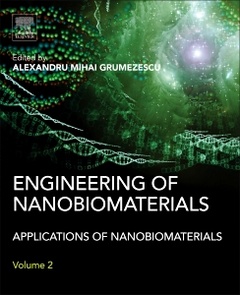Description
Engineering of Nanobiomaterials
Applications of Nanobiomaterials
Coordinator: Grumezescu Alexandru
Language: English
Subjects for Engineering of Nanobiomaterials:
Keywords
Anotoxicology; Ano-bio interfaces; Antibacterial therapy; Antioxidants; Aptamer; Aptasensor; Bending instability; Bio-inspired amphiphiles; Biodegradable; Biological barriers; Biomimic; Bionic eye; Biosensor; Brittle-to-ductile transformation; Caffolds; Cancer; Carbon nanotube; Carbon nanotubes; Cellular barriers; Chemical synthesis; Chemists; Chitosan; Complex dissociation; Complex internalization; Conducting polymer; Conjugated polymer; Contrast agents; Controlled deposition; Cortical; Curcumin; Cyclodextrin; Defects; Discrete element; Dosimeter; Drug delivery; Electric field; Electroactive polymer; Electrospinning; Electrospun; Endosomal escape; Engineered nanoparticles; Epiretinal; Free radicals; Fullerene; Functionalization; Gemini surfactants; Gene delivery; Gene therapy; Gold nanoparticles; Graphene; Green route synthesis; Herapeutics; Human serum albumin; Hydroxyapatite nanoparticles; Inorganic nanoparticles; Iosensors; Magnetic and luminescent properties; Magnetic resonance imaging; Micellization; Mmunogenicity; Multidrug resistance; Nanobiomaterial; Nanofibers; Nanomachining; Nanomaterials; Nanomedicine; Nanopowder; Natural herbs; Nonviral vector; Organic electronics; PLL; Phage display; Physiological barriers; Polyacrylonitrile; Pulsed electron beam; Red blood cells; Retina; Rug delivery; SELEX; SPION; SPIONs; Scanning electron microscopy; Scientists; Self-assembly; Silica nanoparticles; Single-use blade; Stimuli-sensitive nanopreparations; Subretinal; Surfactant-nucleic acid complexes; Surgical operation; Synthesis; Targeting; Theragnostic; Thermal applications; Tumor microenvironment; X-ray diffraction methods; X-ray-contrast substances
Support: Print on demand
Description
/li>Contents
/li>Readership
/li>Biography
/li>Comment
/li>
Engineering of Nanobiomaterials presents the most recent information regarding the specific modifications of nanomaterials and of their synthesis methods, in order to obtain particular structures for different biomedical purposes. This book enables the results of current research to reach those who wish to use this knowledge in an applied setting.
Engineered nanobiomaterials, designed from organic or inorganic raw materials, offer promising alternatives in many biomedical applications. In this book, eminent researchers from around the world discuss the various applications, including antibacterial therapy, biosensors, cancer therapy, stimuli-responsive drug release, drug delivery, gene therapy and visual prostheses. In each case, advantages, drawbacks and future potential are outlined.
This book will be of interest to students, postdoctoral researchers and professors engaged in the fields of materials science, biotechnology and applied chemistry. It will also be highly valuable to those working in industry, including pharmaceutics and biotechnology companies, medical researchers, biomedical engineers and advanced clinicians.
Chapter 1: Engineering of stimuli-sensitive nanopreparations to overcome physiological barriers and cancer multidrug resistance
Chapter 2: Production of complex metal oxide nanopowders using pulsed electron beam in low-pressure gas for biomaterials application
Chapter 3: Bioabsorbable engineered nanobiomaterials for antibacterial therapy
Chapter 4: Organic electronic materials for gene delivery
Chapter 5: Magnetic modification of cells
Chapter 6: Aptamers as functional bionanomaterials for sensor applications
Chapter 7: Gene delivery mediated by gemini surfactants: structure-activity relationships
Chapter 8: Nanobiomaterials for bionic eye: vision of the future
Chapter 9: Bioactive-functionalized interpenetrating network hydrogel (BIOF-IPN)
Chapter 10: Engineered nanomaterials for biomedics: advancements and hazards
Chapter 11: Investigation of the mechanism of nanomachining semiconductor and ceramic blades for surgical applications
Chapter 12: Design and implementation of an electrospinning system
Chapter 13: Engineered nanoparticles: as a precise delivery system in cancer therapeutics
Chapter 14: Inorganic nanoflotillas as engineered particles for drug and gene delivery
Chapter 15: Chemical and green routes for the synthesis of multifunctional pure and substituted nanohydroxyapatite for biomedical applications
Academic: Materials science, biotechnology and applied chemistry professors, PhD, MsC, postdocs, upper level undergraduate students.
Industry: Pharmaceutics and biotechnology companies, medical researchers, biomedical engineers, advanced clinicians.
- An up-to-date and highly structured reference source for students, researchers and practitioners working in biomedical, biotechnological and engineering fields
- A valuable guide to recent scientific progress, covering major and emerging applications of nanomaterials in the biomedical field
- Proposes novel opportunities and ideas for developing or improving engineering technologies in nanomedicine/nanobiology




